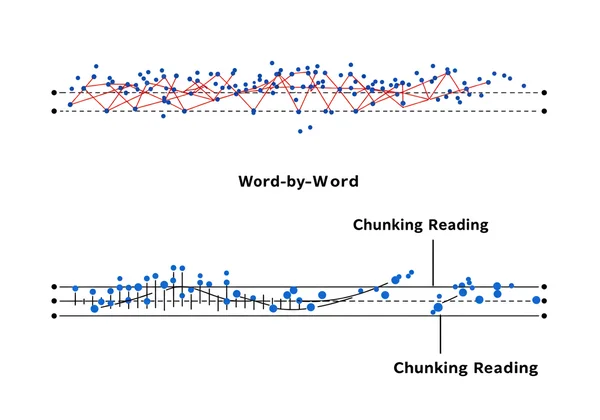Boost Reading Speed: Master Chunking Techniques for WPM
Ever feel like you're drowning in emails, reports, or textbooks? In today's information-rich world, reading quickly and effectively isn't just a skill—it's your secret weapon. For students buried in textbooks, professionals navigating a flood of reports, and lifelong learners with a mountain of books to conquer, slow reading is a significant bottleneck. But what if you could train your brain to process text two or three times faster without sacrificing understanding? Are you tired of slow reading holding you back? This guide will introduce you to reading chunking, a scientifically-backed technique to revolutionize your reading speed and comprehension.

The first step to improvement is knowing your starting point. Before you dive into these techniques, it’s essential to establish your baseline. You can discover your results in just a few minutes with a free and accurate assessment. This will give you a clear Words Per Minute (WPM) score to measure your progress against.
What is Reading Chunking? The Science Behind Block Reading
So, what exactly is reading chunking? Imagine taking in a whole phrase in a single glance. Also known as block reading, it is the practice of reading multiple words at once. Instead of processing text word-by-word, a habit most of us learned in elementary school, chunking trains your eyes and brain to see and interpret words in groups or phrases. This shift is fundamental to breaking the speed barriers that hold most readers back.
Think of it like this: an untrained reader's eyes stop on almost every single word, making a dozen tiny stops (or "fixations") per line. A proficient chunker might only make three or four fixations per line, absorbing three to five words with each stop. This simple change dramatically reduces the physical work your eyes do and allows your brain to process information at a much higher rate.
From Word-by-Word to Whole Thoughts: Why Chunking Works
Reading word-by-word is inefficient because we don't think in single words; we think in ideas and concepts. When you force your brain to process text one word at a time, you increase its cognitive load by making it assemble the meaning from tiny, disjointed pieces. This is not only slow but also hinders comprehension because you're too focused on the individual words to see the bigger picture. Think about the last time you rushed through a complex document – did you truly grasp it, or did you find yourself rereading sentences?
Chunking aligns your reading method with how your brain naturally works. By absorbing phrases like "the marketing report" or "on the other hand" as a single unit, you grasp the meaning more fluidly and instantly. This frees up mental resources, allowing you to focus on the author's message and how different ideas connect, leading to a much deeper level of understanding.
The Role of Visual Span in Faster Reading
Your visual span is the number of words you can accurately perceive and identify in a single glance without moving your eyes. Most untrained readers have a narrow visual span, often limited to one or two words at a time. The key to successful chunking is actively working to expand this span.
By training your peripheral vision, you can learn to see and register words to the left and right of your central fixation point. As your visual span widens, you can take in larger chunks of text with each stop. This reduces the number of eye movements, or saccades, needed to cross a line of text, which is one of the most significant physical limitations on reading speed. The exercises below are designed to help you do exactly that.

Practical Speed Reading Techniques: How to Improve Reading Speed with Chunking
Understanding the theory is one thing; putting it into practice is what creates results. The following exercises are designed to be simple, effective, and easy to integrate into your daily routine. Remember, consistency is more important than intensity. A little practice each day goes a long way. To see the impact of these drills, consider taking a free reading speed test before you start and after a week of practice.
Exercise 1: The 3-Word or 4-Word Focus Drill
This drill is designed to break the habit of single-word fixation and force your eyes to move in larger jumps. It builds the muscle memory for chunking.
- Find Your Material: Open a book or an article with standard-width columns.
- Use a Pacer: Take a pen or your finger and place it under the first line of text.
- The Drill: Instead of reading every word, bounce your pacer and your eyes to specific fixation points. Start by aiming to make just three stops per line. For example, look at the second word, then the middle word, then the second-to-last word.
- Focus on Vision, Not Voice: Your goal is to see the words, not say them in your head. Initially, your comprehension will drop. That's normal. Focus only on the physical eye movements.
- Practice: Do this for 3-5 minutes. Gradually increase your speed as you become more comfortable. The goal is to train your eyes to trust that they can see the words in between your fixation points.
Exercise 2: Expanding Your Peripheral Vision & Chunking Awareness
This exercise focuses on using your peripheral vision to capture more text, which is crucial for effective chunking.
-
Center Focus: As you read a line of text, try to focus your gaze on the middle of the line.
-
Relax Your Gaze: Instead of a hard focus, soften your gaze and try to become aware of the words at the beginning and end of the line using your peripheral reading abilities.
-
The "Z" Pattern: Practice moving your eyes in a "Z" pattern. Sweep across the first line, then diagonally down to the beginning of the next line, and sweep across again. This encourages your eyes to grab chunks of text rather than individual words.
-
Start Easy: Begin with material that is easy for you to understand. This allows you to concentrate on the technique without struggling with complex content.

Overcoming Common Obstacles: Reducing Subvocalization & Regressions
Two of the biggest barriers to faster reading are subvocalization (the habit of saying words in your head) and regressions (unnecessary re-reading). Improving your reading habits is key. Chunking directly helps combat both.
When you focus on absorbing groups of words, your brain is too busy to subvocalize each one, gradually silencing that inner narrator. Likewise, as you train your eyes to move forward consistently, you reduce the habit of flicking back to re-read words. Trusting your comprehension and pushing forward is a skill that chunking helps build. If subvocalization is a major issue, try humming softly while you practice these drills to occupy your inner voice.
Integrating Chunking into Your Daily Reading Practice
Exercises are for the gym; the real test is applying your skills in the real world. The goal is to make chunking your new default reading style. Start by applying the techniques to your daily reading—whether it's news articles, emails, or chapters in a book.
Timed Chunking Drills & WPM Test Tracking
Dedicate 10-15 minutes each day to conscious practice. Set a timer and read using the chunking techniques you've learned. The purpose of this timed practice is to push your comfort zone and build speed.
The most effective way to validate your progress is through consistent measurement. After each practice week, take a WPM test to see how your speed and comprehension are improving. Seeing your numbers climb is a powerful motivator. A good reading pace calculator not only shows your speed but also tests your understanding to ensure you're not just skimming.
The Importance of Comprehension Alongside Speed
Let's be clear: the goal is not speed at all costs. The goal is effective reading, which balances speed with understanding. There is no point in reading 800 WPM if you retain nothing. That's why our core philosophy is built on dual assessment.
As you practice chunking, your comprehension might dip temporarily. This is expected. As you get more skilled, your brain will adapt, and your comprehension will return to—and often exceed—its previous levels. Always follow up your speed practice with a reading comprehension test to ensure your learning remains effective. The feedback from a reliable WPM test is invaluable for finding the right balance.
![]()
Your Journey to High-Efficiency Reading Starts Now
You've just uncovered the power of reading chunking – a skill that can fundamentally transform how you consume information, freeing up your time and boosting your mental agility. This isn't just about reading faster; it's about learning more, understanding deeper, and achieving your full reading potential. The path is clear: consistent practice and smart measurement. You now have the knowledge. Are you ready to put it into action?
Ready to see how much faster you can read? Take our free WPM test now, set your benchmark, and begin your journey to becoming a more efficient and powerful reader today!
Frequently Asked Questions About Reading Speed & Chunking
What is a good reading speed for an adult?
The average reading speed for an adult is around 200-250 WPM. A speed of 300-400 WPM is generally considered good, as it signifies efficient reading with solid comprehension. However, the "best" speed depends on the material's complexity and your reading goal. You can easily find your personal metric by taking a quick WPM test.
How can I improve my reading speed and comprehension?
The most effective method is to practice techniques like reading chunking to increase your visual span and reduce subvocalization. Equally important is to consistently measure your progress. Use a tool that provides both a WPM score and a comprehension quiz to ensure you are improving both skills in tandem. Regular practice and feedback are the keys to balanced improvement.
Does practicing chunking help stop subvocalization when reading?
Yes, absolutely. Subvocalization is the habit of pronouncing each word in your mind, which limits your reading speed to your talking speed. Chunking forces you to take in groups of words at once. Your brain simply doesn't have time to "say" every word, which helps to break the habit and encourages you to process text visually.
Is 1000 WPM truly possible with speed reading techniques?
While speeds of 1000 WPM are often advertised, they are extremely rare and typically involve advanced skimming or scanning techniques, often with a significant drop in comprehension. For most people, a more realistic and highly beneficial goal is to double or triple their current reading speed while maintaining or even improving comprehension. A goal of 400-600 WPM is very achievable and will make a massive difference in your productivity. You can assess your skills right now to see where you stand.